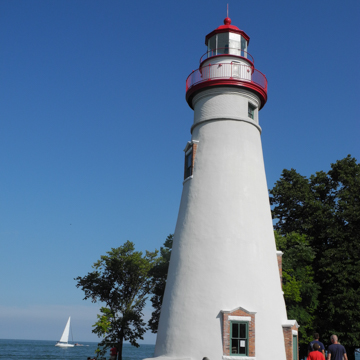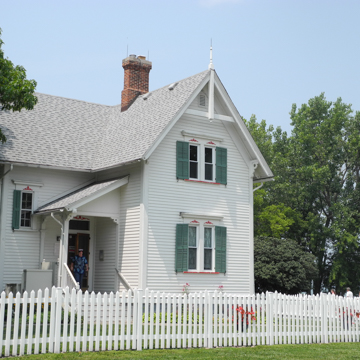The Marblehead Light, built in1821, is located on the northeastern tip of the Marblehead Peninsula, at the edge of the village of Marblehead. It is the second lighthouse built on the Great Lakes, and the oldest one remaining in continuous service. Most of Ohio’s surviving nineteenth-century lights are replacement structures, sometimes the second or third to be built on the same site.
Lake Erie is bounded on the north by Canada, on the south by the entire 184 miles of Ohio shoreline, a small portion of Michigan to the west, and small areas of Pennsylvania and New York to the east. At 9,940 square miles, it is the fourth largest of the five Great Lakes. Only 58 miles across at its widest point, and with a mean depth of just 90 feet, its shallowness has long contributed to Lake Erie’s characteristic turbulence and frequent and fierce storms. While Congress authorized construction of the first lighthouses on the Eastern seaboard in 1789, on Lake Erie, mariners had to rely on natural landmarks along the shoreline to sail unscathed through the uncharted lake. Following the War of 1812, however, the number of ships on Lake Erie grew, as did the need for lights to provide navigational aids to sailors at night and function as landmarks during the day. Lake Erie’s first lighthouses were completed at Buffalo, New York, and Presque Isle (Erie) Pennsylvania, around 1818 and lighthouses at Marblehead, Detroit, Michigan; and Grand River (1825, now Fairport Harbor) and Cleveland (1829), both in Ohio, quickly followed. By 1840 a total of 43 lights, 17 of which were on Lake Erie, marked the Great Lakes. By 1852, an additional 33 lights were established.
Settlement in the Great Lakes region was slow until the 1825 completion of the Erie Canal provided Buffalo and points west with a link to the markets in New York City via the Hudson River. Natural harbors, located at the mouths of the many rivers that dotted Ohio’s Lake Erie shoreline, were pressed into service as commercial ports, enabling agricultural products and raw materials to flow east and manufactured products to flow west. With increased settlement, commerce grew exponentially in the western interior. By 1860, 369 steam-powered ships and 1,207 sailing vessels traveled regularly on the Great Lakes, mainly carrying agricultural products; in the 1880s and 1890s they were replaced by steel-hulled freighters transporting lumber, stone, iron ore, and coal.
The U.S. Secretary of the Treasury directed the establishment and maintenance of the lights until 1820, when the responsibility was delegated to the Fifth Auditor, Stephen Pleasonton. It was Pleasonton who selected the northeastern tip of the Marblehead Peninsula, at the confluence of Lake Erie and Sandusky Bay, as the site for what was known as the Sandusky Bay Light until 1870.
The land for the new lighthouse was purchased for $300 with Congress appropriating additional funds for construction—$10,000 for the lighthouse and $6,520 for the keeper’s house. Assumed to have been designed by the military engineer assigned to the district, what is now the Marblehead Lighthouse was built in 1821 and the Keeper’s House was completed in 1822. Stephen Woolverton, the original contractor, sublet construction to William Kelly. A stonemason who came to Ohio from New York in 1818, Kelly completed the conically shaped lighthouse with assistance from his son, John Reid Kelly, along with A. Hartshorn and Amos Fenn. Built of native limestone, the lighthouse was originally unpainted.
The lighthouse was originally 50 feet high, but a brick watch room constructed at its top in 1897 added 15 feet. The lighthouse is 25 feet in diameter at its base, with 5-foot-thick walls. The walls graduate to 2 feet thick at the top of the cone, where the diameter is 12 feet. Repairs and restorations have been required over the years. In 1880 the exposed limestone exterior was covered in stucco and painted white. During the 1897 extension, the windows and the door were embellished with hood moldings and a wrought-iron railing and roof, both of which are now painted red, were added to cap the spire. A severe flood in 1974 caused significant damage to the surface of the tower. Subsequently, the exterior surface of the entire tower was skinned, repointed, and a gunite surface applied.
Winslow Lewis fabricated the original white beacon, which consisted of 13 Argand lamps fueled by whale oil, with a 16-inch reflector lamp behind each lamp. In 1858, a fourth-order Fresnel lens was installed; it required only one lamp, which was operated first using lard oil, and later, kerosene. In October 1897, a larger lantern from a decommissioned lighthouse in Erie, Pennsylvania, replaced the Fresnel light. The new light had a rotating “clockwork system” mechanism that gave an intermittent signal. In 1923 electricity was installed, increasing the light’s candlepower from 42,000 to 350,000 candles, and the visibility to 16 miles. The light was changed from white to red in 1930. In 1969, the light was changed from red to green and equipped with an intermittent red beam. In 2013, the Coast Guard changed the light to a 2-tiered, 20-watt LED that emits a tightly controlled, intense green beam. The current light was made by Vega of New Zealand.
Original outbuildings on the property included the Keeper’s House, a combined coal storage/outhouse (now privately owned), a barn for the keeper’s animals, an icehouse (later moved and attached to the barn), and a now-demolished boathouse. In the 1890s, two circular, brick-and-iron oil houses were constructed to store the kerosene and mineral oil used to fuel the lighthouse light. The original Keeper’s House, built in 1822 of the same native limestone as the lighthouse, was listed as “dwelling house, kitchen, and accompanying outhouse there on erected, finished, and in complete order, with windows glazed in each, with good well water, water bucket, chain, and krib.” The present Keeper’s House was completed in 1880; it is a 1.5-story frame structure with clapboard siding, a steeply pitched gable roof, and a small side porch. It contained an assistant keeper’s apartment on the upper level.
Since its inception, the Marblehead Lighthouse has had 15 keepers, beginning with Benejah Wolcott, who served from 1822 until his death from cholera in 1832, when the U. S. government appointed his widow, Rachel Miller Wolcott, as the first female keeper on the Great Lakes. She held the position until 1834. Johanna McGee, keeper from 1896 to 1903, was the widow of the previous keeper, George McGee, who served in 1873–1896.
In the early to mid-1940s, ownership of the Marblehead Lighthouse was transferred to the U.S. Coast Guard, which also assumed responsibility for maintenance. Since 1972, the property surrounding the lighthouse has been maintained by the Ohio Department of Natural Resources. It became Marblehead Lighthouse State Park in 1998. The Keeper’s House is now a museum, operated by the Marblehead Lighthouse Historical Society and staffed by Historical Society volunteers. The park is open year round, and the lighthouse tower and the Keeper’s House Museum, which displays the original Fresnel lens, are open for tours during the summer.
References
Gordon, Virgil M., “Marblehead Lighthouse,” Ottawa County, Ohio. National Register of Historic Places Inventory–Nomination Form, 1969. National Park Service, U.S. Department of the Interior, Washington, D.C.
“Marblehead Lighthouse.” Marblehead Lighthouse Historical Society. Accessed November 20, 2018. http://www.marbleheadlighthouseohio.org.
Miller, Carol Poh, “Light Stations of Ohio.” National Register of Historic Places Multiple Property Documentation Form, 1991. National Park Service, U.S. Department of the Interior, Washington, D.C.
Mollenkopf, Jim. Lake Erie Sojourn. Toledo, OH: Lake of the Cat Publishing, 1998.
Neidecker, Betty. The Marblehead Lighthouse: Lake Erie’s Eternal Flame. Privately printed, 1995.
O’Connell, Wil and Pat. “From Ugly Duckling to Beautiful Swan.” In Images of America, Ohio Lighthouses. Charleston, SC: Arcadia Publishing, 2011.























